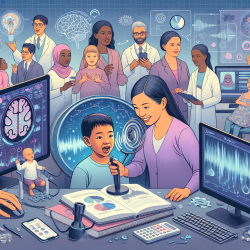Introduction
In the field of speech-language pathology, data-driven decision-making is crucial for enhancing therapeutic outcomes. Recent research, such as the study on CH4 adsorption probability during metalorganic vapor phase epitaxy, offers valuable insights that can be leveraged to improve practices in speech-language pathology. While this study focuses on semiconductor growth, its methodology and data-driven approach can be adapted to our field to optimize therapy outcomes for children.
Understanding the Research
The study investigates the adsorption probability of methane (CH4) on gallium nitride (GaN) surfaces during the metalorganic vapor phase epitaxy process. The research highlights the importance of understanding impurity incorporation and its effects on material properties. By employing a sequential analysis based on first principles calculations, the study provides a model for predicting carbon contamination, which is crucial for improving the quality of GaN films.
Applying Research Methodologies to Speech-Language Pathology
While the study is specific to semiconductor materials, its methodological approach can be adapted to speech-language pathology. Here’s how:
- Sequential Analysis: Just as the study uses sequential analysis to understand impurity incorporation, speech-language pathologists can use a similar approach to analyze therapy progress. By breaking down therapy into sequential steps, practitioners can identify which interventions are most effective at each stage.
- Data-Driven Decisions: The study's reliance on data to predict outcomes can inspire speech-language pathologists to collect and analyze data on therapy sessions. This can include tracking speech improvement over time and adjusting interventions based on empirical evidence.
- Modeling Outcomes: Creating models to predict therapy outcomes based on initial assessments and ongoing data collection can help practitioners tailor interventions to individual needs, much like predicting impurity concentrations in GaN films.
Encouraging Further Research
The research on CH4 adsorption probability underscores the value of detailed, data-driven analysis. Speech-language pathologists are encouraged to engage in further research and collaboration to develop models that predict therapy outcomes based on various factors, such as age, initial speech capabilities, and specific speech disorders.
Conclusion
By embracing data-driven methodologies and insights from diverse fields, speech-language pathologists can enhance their practice and improve outcomes for children. The study on CH4 adsorption probability provides a framework for understanding the importance of detailed analysis and prediction models, which can be applied to our field to optimize therapy interventions.
To read the original research paper, please follow this link: CH4 Adsorption Probability on GaN(0001) and (000?1) during Metalorganic Vapor Phase Epitaxy and Its Relationship to Carbon Contamination in the Films.










